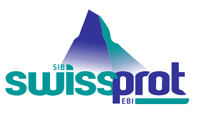Swiss-Prot

|
WikiDoc Resources for Swiss-Prot |
|
Articles |
|---|
|
Most recent articles on Swiss-Prot |
|
Media |
|
Evidence Based Medicine |
|
Clinical Trials |
|
Ongoing Trials on Swiss-Prot at Clinical Trials.gov Clinical Trials on Swiss-Prot at Google
|
|
Guidelines / Policies / Govt |
|
US National Guidelines Clearinghouse on Swiss-Prot
|
|
Books |
|
News |
|
Commentary |
|
Definitions |
|
Patient Resources / Community |
|
Patient resources on Swiss-Prot Discussion groups on Swiss-Prot Patient Handouts on Swiss-Prot Directions to Hospitals Treating Swiss-Prot Risk calculators and risk factors for Swiss-Prot
|
|
Healthcare Provider Resources |
|
Causes & Risk Factors for Swiss-Prot |
|
Continuing Medical Education (CME) |
|
International |
|
|
|
Business |
|
Experimental / Informatics |
Overview
Swiss-Prot is a manually curated biological database of protein sequences. Swiss-Prot was created in 1986 by Amos Bairoch during his PhD and developed by the Swiss Institute of Bioinformatics and the European Bioinformatics Institute.[1] Swiss-Prot strives to provide reliable protein sequences associated with a high level of annotation (such as the description of the function of a protein, its domains structure, post-translational modifications, variants, etc.), a minimal level of redundancy and high level of integration with other databases.
In 2002, the UniProt consortium was created: it is a collaboration between the Swiss Institute of Bioinformatics, the European Bioinfomatics Institute and the Protein Information Resource (PIR), funded by the National Institutes of Health. Swiss-Prot and its automatically curated supplement TrEMBL, have joined with the Protein Information Resource protein database to produce the UniProt Knowledgebase, the world's most comprehensive catalogue of information on proteins.[2] As of 3 April 2007, UniProtKB/Swiss-Prot release 52.2 contains 263,525 entries. As of 3 April 2007, the UniProtKB/TrEMBL release 35.2 contains 4,232,122 entries.
The UniProt consortium produced 3 database components, each optimised for different uses. The UniProt Knowledgebase (UniProtKB (Swiss-Prot + TrEMBL)), the UniProt Non-redundant Reference (UniRef) databases, which combine closely related sequences into a single record to speed similarity searches and the UniProt Archive (UniParc), which is a comprehensive repository of protein sequences, reflecting the history of all protein sequences.
References
- ↑ Bairoch Amos (2000). "Serendipity in bioinformatics, the tribulations of a Swiss bioinformatician through exciting times!". Bioinformatics. 16: 48–64. PMID 10812477. External link in
|title=(help) — a historical account by Bairoch. - ↑ Wu, C.H. et al. (January 2006) "The Universal Protein Resource (UniProt): an expanding universe of protein information.". Nucleic Acids Research, 1;34 (Database issue): D187–91.
External links
- Swiss-Prot Protein Database (Swiss Institute of Bioinformatics)
- UniProt (Swiss Institute of Bioinformatics)